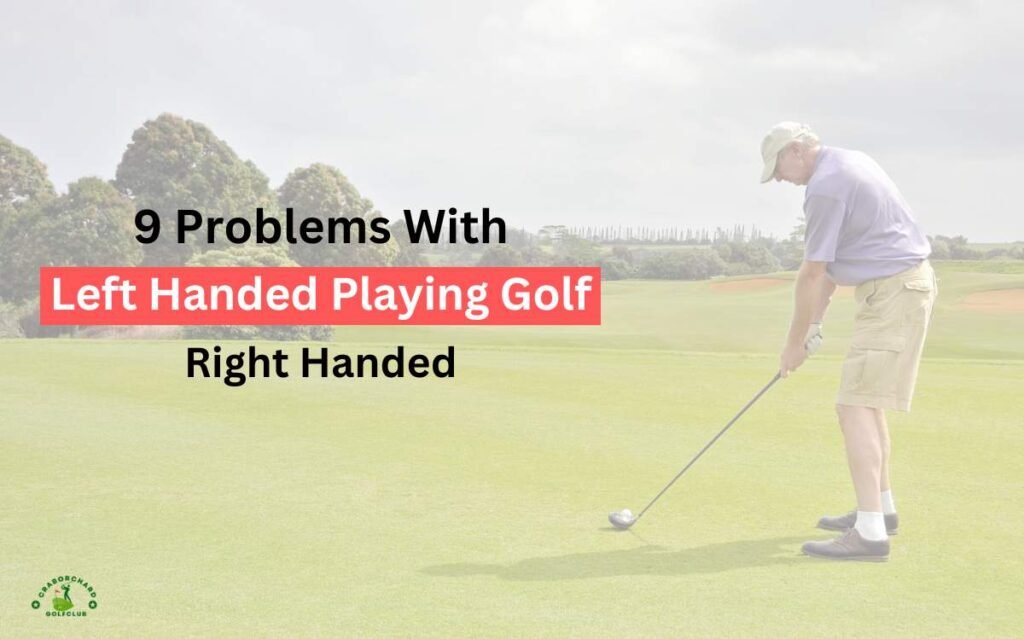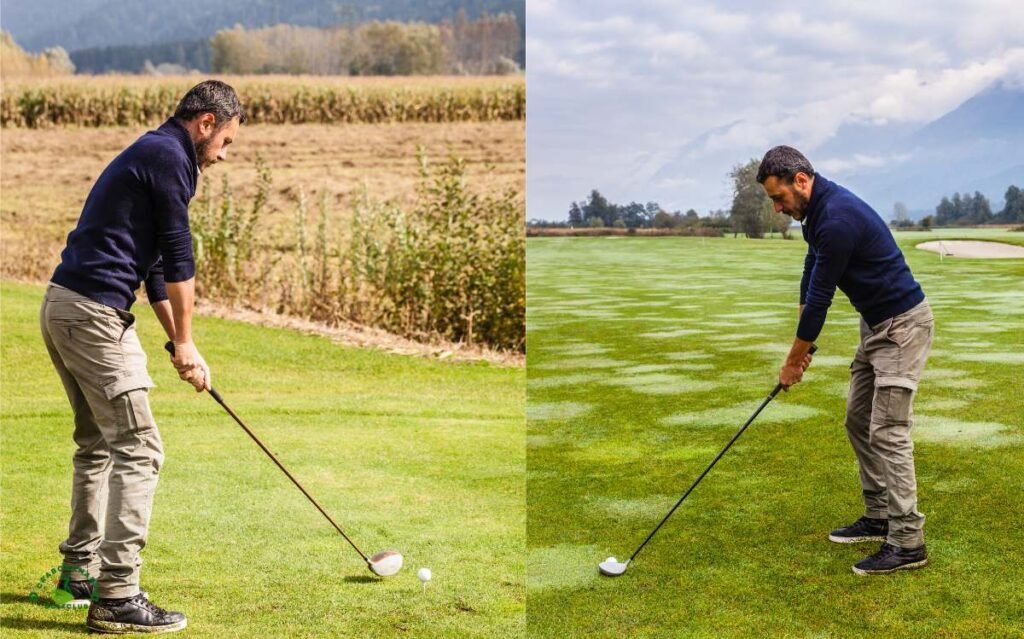9 Problems With Left Handed Playing Golf Right Handed [2024!]
You’ve heard the story of Jordan Spieth – A three-time major winner who plays right-handed golf despite being a lefty. But is switching hands the right thing to do for you?
Why not first go through the problems with left handed playing golf right handed?
Read on to learn more about the challenges of switching hands while playing golf.

Why Do Left-Handed Golfers Find It Difficult to Play with the Right Hand?
When you’re accustomed to striking your club with a specific hand, your whole body is trained to move in a certain way. Therefore, when you try to change your game and switch hands, it creates a wide range of issues, including:
1. Lack of Coordination and Accuracy While Releasing
As studies have shown, your dominant hand is more coordinated and follows a straighter hand path during dynamic interactions.
Using your dominant arm also results in low errors in the direction of the action. Therefore, when you’re a lefty with years of practice utilizing your left hand, you’ll notice a lack of coordination and accuracy as you release the club through the impact zone.
2. Improper Grip Leading to a Slice or Hook
According to golf swing mechanics, a good swing requires a firm grip and precise rotation of your wrists, arms, and shoulder joints. If you’re a lefty playing right-handed, your lead arm is the left arm, which determines the control and stability of your clubface at impact.
For left-handed golfers, the lead position feels unnatural, leading to a weak grip and early release of the club.
Hence, instead of a smooth release where the wrists naturally roll and unhinge, they flip the club. It causes the clubface to open and shots to slice or pull.
And what if you grip the club too strongly? The clubface will be angled to the left of the target line and create hooks.
3. Interruption in Hand-Eye Coordination
For about 65% of people, their dominant hand and eye are the same. So, if you’re a lefty, your left eye is more likely to be your dominant eye.
Your natural dominant hand-eye coordination is disrupted when you play with your right hand. It affects your ability to absorb and assess visual information related to the golf course elements such as distance, topography, elevation, and obstacles.
Other aspects related to swing and hitting the ball including teeing off, initiating downswing, hitting the fairway wood, aiming the target, etc., are also hampered.
4. Difficulties in Weight Shifting
Another common issue many left-handed golfers face while switching hands is weight-shifting difficulties. In a proper swing, your body weight primarily shifts to your back foot during the backswing.
However, when you play right-handed, your dominant left side, including your leg, hip, and foot, is naturally more active due to muscle memory.
It will create all types of problems, like over-shifting the weight to your wrong foot, disrupting the sequence of the swing, and lack of power while striking.
5. Bad Putting Performance
Many studies have suggested the importance of visual processing in putting as it’s essential in aiming and determining the slope and focus area.
Playing opposite-handed golf can disrupt the natural connection between your dominant left eye and hand coordination. Consequently, it impacts your ability to judge distance and feel the putter shaft head through the stroke.
Due to such erratic clubface alignment and improper hand-eye, you keep struggling with putting.
6. Loss of Lag
In golf, lag refers to the separation created between the upper and lower body during the downswing for efficient energy release.
While swinging the club, the pressure shift should follow a specific sequence into your hips, chest, and foot for effective lag. Besides, you must control your wrist movements, including radial deviation, extension, and flexion.
As a left-handed golfer, your upper and lower body limbs are taught to rotate in a certain way, thanks to years of practice.
If you play right-handed golf, your dominant body limbs will fire early and disrupt the complete sequence. This will eventually lead to a loss of power, accuracy, and consistency.
7. Shot Shaping Limitations
Achieving your desired shot shapes, such as draws or fades, becomes more challenging when you use the wrong hand. In general, the trajectory of the ball depends on the attack angle when you strike the ball and the clubface loft.
Both of these are affected when you switch hands, leading to unwanted shot shapes. Moreover, left-handed golfers find it difficult to manipulate the clubface for an intentional draw or fade if they play right-handed.
As a result, it hampers their ability to navigate various course situations and lowers their scores.
8. Hassles of Choosing the Right Equipment
Getting the right club fit depends on your skill level, club angles, swing characteristics, and many other factors. Therefore, when you switch hands, the first thing you need to do is get a new golf set designed for right-handed players.
Choosing the right club for each shot as a lefty can be a hassle, even with professional help. Not to mention the added cost of purchasing new equipment.
9. Long Learning Curve
If you’ve been playing golf with your left hand for years, getting accustomed to using your right hand will be hard. It takes years of practice to develop the right techniques based on your playing style and body coordination.
As you switch hands, you’ll have to work on your wrist movements, arm position, and the angle of your foot, hip, shoulders, and legs. Going through such a long process and getting inconsistent results often becomes frustrating.
Why Do Professional Golf Players Switch Hands? Studies Reveal the Big Benefits of Reverse Stance
Popular players like Phil Mickelson and Jordan Spieth are known to have switched hands to achieve better results.
In fact, one study has suggested that 21.5% of professional golfers are more likely to use their non-dominant hand. Why so? Here are the possible benefits of switching hands while playing golf:
Powerful Strokes
Golfers who switch hands reported that it’s often easier to strike with your wrong hand. That’s because your non-dominant hand is placed a bit further from the point where the ball meets the club.
Therefore, the main pivot is further from your dominant hand. As a result, players generate more power while striking the club and reaching greater distances.
Greater Accuracy
To avoid slices, hooks, fat, or thin shots, you need to have an excellent grip and control over your lead arm. By switching hands, you allow the dominant arm to lead.
For professional and grade-A golfers, it’s easy to control their dominant arm and achieve the perfect grip. Therefore, they get to keep their lead arm straight, preventing bents and unusual angles. This way, the golfer gets to strike with more accuracy.
Better Results in One-On-One Games
According to a study, left-side players often enjoy a certain performance advantage over right-handed opponents. Although left-handed golfers are more adaptable to playing reverse stances, the dominant hand isn’t necessarily the key reason for improved motor skills.
However, when you play one-on-one with an opponent who can only play with the dominant hand, using both hands becomes surprisingly beneficial.
Stress Management and Comfort
Switching hands while playing for long hours can distribute the workload of the swing more evenly. It often reduces stress and fatigue on the dominant hand and arm.
Besides, some players are just more comfortable playing with their wrong hand as it allows the non-dominant side of the body to take a more active role.
Left Vs Right Hand Golf Differences At a Glance


Now, let’s go through the differences between playing golf with your right and left hand to understand which one might be a better option for you.
| Comparable Aspects | Left-Handed Golfer | Right-Handed Golfer |
| Hand Placement | Right hand below, left hand above | Left hand below, right hand above |
| Swing Direction | Inside-out, promotes draw | Outside-in, promotes fade |
| Common Ball Flight | Hook (ball curves left) | Slice (ball curves right) |
| Availability of Equipment | Difficult to find | Widely available |
| Regular Course Shape | Not as favorable | Highly favorable |
| Success Rate | Higher | Lower |
in our verdict – problems with left handed playing golf right handed
Before you decide to play golf with your wrong hand, it’s best to consider the problems with a left-handed player playing golf with the right hand.
The key problems are related to your natural tendency to use your dominant left hand in a certain way when swinging your club. Although difficult, it’s not altogether impossible to improve your game by switching hands.
All you need to do is regularly practice the right-handed drills, test your expertise with different clubs, and take professional coaching to enhance your skills with the non-dominant hand.
Continue Reading….

![What To Wear To A Golf Lesson? [And What Not To Wear]](https://www.craborchardgolfclub.com/wp-content/uploads/2024/03/What-To-Wear-To-A-Golf-Lesson-768x479.jpg)
![Who Makes Vessel Golf Bags? Vessel Golf Bags Reviews [2024!]](https://www.craborchardgolfclub.com/wp-content/uploads/2023/09/Who-Makes-Vessel-Golf-Bags-768x512.webp)


